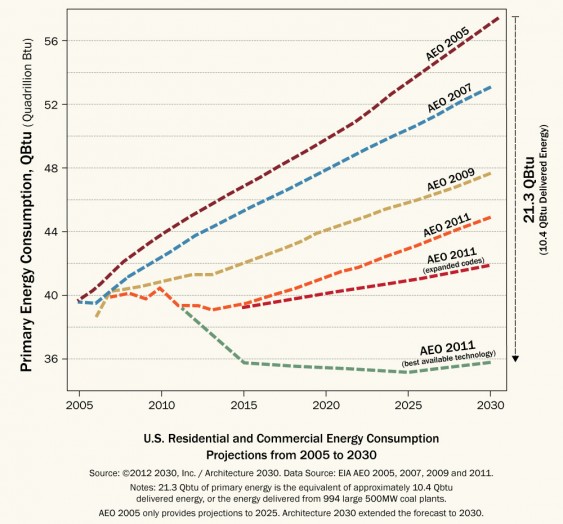Architecture 2030 has a pithy analysis showing the huge strides the US is making in energy efficiency. Just a few years ago, the department of energy forecasted a massive increase in energy use for the residential and commercial sectors. Now, we’re looking forward to a future with flat energy demand in the near-term and a range of possibilities for the future.
That’s progress on two major fronts.
First and foremost, the new lower energy demand forecast is proof of what’s working in the building sector. We’re seeing better building codes, greater investment in energy efficiency, and more widespread adoption of green building practices. Three cheers, then, for everyone who’s been pushing forward on green building issues in all their breadth and complexity.
The new forecasts also represent progress in another important sense. The United States’ official forecasts for the building sector are now pointing toward a greener energy future that just a few years ago was derided as Pollyanna and naive. That matters.
A lot.
It’s these official forecasts that show the “need” for new power plant construction, for more coal mining, for more natural gas fracking, and so on. And it’s these forecasts that have too often under girded pessimistic beliefs that climate policy can’t make a difference, and that the nation is locked into decades of fossil fuel dependence.
In fact, as the Architecture 2030 analysis shows, lower energy demand forecasts represent a huge economic boon to Americans:
It’s worth amplifying this message. When we talk about green building, in all of its various forms, we’re talking about trillions of dollars in energy savings for American residents and businesses.
That’s just under current forecast scenarios. For what it’s worth, my best guess is that the official projections are still too cautious and that advancement in policy (and technology) will yield not only better forecasts in the future, but a better actual future too.
H/t to Levin Nock











Ryan
Eric, thank you for posting this well-written article and including such valuable data. The research certainly goes a long way toward disproving the Jevons paradox (at least as it relates to energy efficiency). It’s great to see homeowners, contractors, and government agencies all teaming up to encourage others to go “Green.” I think a lot of people would be shocked by how much of an impact home improvement projects, such as insulation or energy efficient replacement windows, can have on heating and cooling bills, as well as overall energy usage. Thanks again for posting this insightful article and data!
Philippe
Any local data about Seattle and the Puget Sound region? concrete examples of the impact of programs like sustainableworks and others?
Kim
You can go to the NW Energy Coalition sight to see how much energy efficiency Washington utilities produced to comply with I-937 the Clean Energy Initiative: http://www.nwenergy.org/policy/celebrating-washingtons-clean-energy-success/
And for regional savings, you can get all the data in the world at the Northwest Power and Conservation Council site. Spoiler alert – it’s alot. Since the 1980’s, enough energy efficiency to meet half the region’s growth in electricity use – avoid 8 to 10 fossil fuel generating plants.
http://www.nwcouncil.org/energy/powerplan/6/default.htm
Kim
Energy efficiency is an incredibly good news story – but a big share of these savings are from state and federal appliance and equipment efficiency standards. Thanks to standards that became effective from 1987 – 2010, U.S. energy use in 2010 was about 3.6% lower than it would have been. Just one example, today’s refrigerators use less than half the electricity used by a fridge in 1990 – and the modern fridges are bigger and cost essentially the same to buy as they did when they were energy hogs.
The other cool thing about efficiency standards is that they make it easy for consumers to make the right choice. And, they do an incredible job of driving innovation: in 2009, California adopted TV efficiency standards requiring TVs to be 30% to 50% more energy efficiency – today, nearly all TVs on the market (on the West Coast) exceed those standards with picture quality that is better than before.